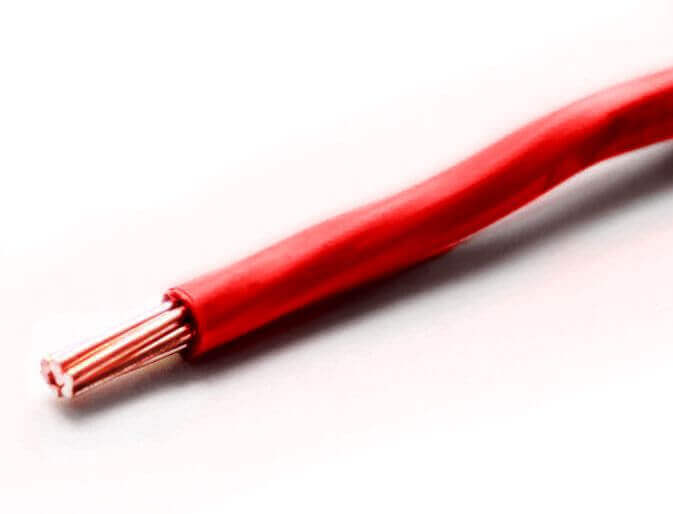PuV wire specifications
Labeling Explanation
To understand why this wire is used, you need to understand how its marking is deciphered. In our case, it is decrypted as follows:
- P - wire;
- y - installation;
- B - vinyl insulation.
In the abbreviation there is no letter “A” at the beginning, from here it becomes clear that the PuV wire is copper. The numbers that follow the marking indicate the cross-sectional area of the conductive core, for example, in PuV-2.5, the cross-sectional area is 2.5 square meters. mm
Design features
The conductive core consists of one or more copper wires, such conductors are often called monolithic, single-wire or rigid. The core is covered with a layer of insulation made of PVC compound.
Important! PuV wires with a cross section up to 10 sq. mm is produced with one conductive core, and over 16 square meters. mm - multi-wire conductors. Where it can be used depends on the composition of the conductor!
Features of monolithic veins is their low flexibility, but they keep the shape that they are given. This will ensure a neat wiring, and the wiring in the shield will not sag and get confused.
It is interesting that the PuV wire is made in accordance with GOST 6323-79, and the conductive core corresponds to GOST 22483-77 - this determines the correspondence of the wire to its characteristics, which we will talk about later.
The insulation can be either solid monochrome or consist of green and yellow stripes - this solution is used for laying grounding conductors. When ordering a conductor, as in other cases, you need to specify what color of insulation you need.
Specifications
For PuV wire, the technical characteristics correspond to the brands of conductors similar in scope. Let's consider them in more detail.
- Alternating voltage 450V at a frequency of up to 400 Hz.
- Constant voltage - up to 1000V.
- The range of permissible operating temperatures is from -50 to +65 degrees Celsius with humidity up to 98%.
- The minimum temperature at which wiring is allowed is at least -15 degrees Celsius.
- The maximum heating temperature of the core is 70 degrees Celsius.
- Insulation resistance at a temperature not lower than -20 degrees Celsius - 20 MΩ
- Minimum bending radius of at least 10 outer diameters of the wire.
- Service life - up to 20 years (in the absence of harmful factors such as direct exposure to ultraviolet radiation, too high and low temperatures).
- Warranty period is 3 years.
- Flexibility class - 1.
An equally important characteristic is the resistance of the conductive wire Ohm / km. These values, as well as the weight and number of sections you see in the table below.
PuV wires comply with international standards IEC 60227-1: 2007, IEC 60227-3: 1997, IEC 60227-4: 1997.
It is also worth noting that compliance with technical specifications is performed only if the requirements for storage, installation, transportation and operation of the product are met. Therefore, at all stages it is important to exclude insulation damage, improper installation, inappropriate PUE.
Scope of application
Let's see where the wire in question is used. The technical characteristics of PuV allow it to be used for laying inside electrical panels or for mounting power lines in electrical equipment. Welders are an example of such equipment, and they often collect heat gun circuits.
In electrical panels, the conductor is conveniently used as jumpers for phase distribution between circuit breakers and other elements of the panel. In addition, the single-wire PuV wire does not need to be crimped with ferrules for connection with a screw clamp, which are used in the same machines, RCDs, meters and more.
Also, the characteristics allow it to be used for mounting lighting circuits or other power lines when laying in corrugated pipes, cable channels or metal hoses.
Analogs and best manufacturers
PuV wire replaced obsolete PV-1They have almost identical specifications and purpose. If you need to carry out installation in hard-to-reach places, a flexible analogue is suitable for this - PuGV or PV-3.
Visitors often ask the question "How is PuV different from PuVV?" Their main difference is the flexibility class, for PuGV it is 5, and for PuV - 1. This is due to the fact that the PuGV has a multi-wire design, otherwise their technical characteristics almost completely coincide.
Many enterprises produce such a conductor, among them we can distinguish:
- Podolskkabel OJSC, Podolsk;
- JSC "Rosskat", Neftegorsk;
- LLC Dmitrov-cable, Dmitrov.
This concludes our review of the characteristics of the PuV wire. We hope the material provided was useful and interesting for you!
Also read:










